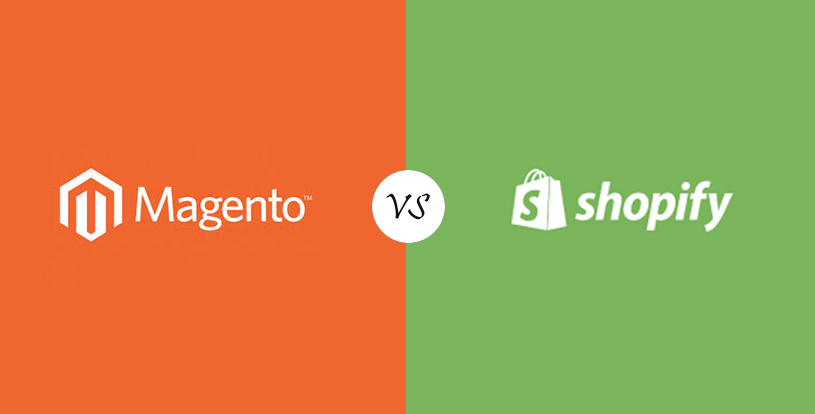Magento Vs. Shopify – What Are the Key Differences?
According to Statista, 75 percent of people shop online at least once a month, and eCommerce sales are predicted to hit $6.5 trillion by 2023. That’s a huge market. The accessibility of buying things with a click of the button in the comfort of your own home has become increasingly more appealing over the years and it’s not going to stop anytime soon. Processing is simple with platforms like Magento and Shopify, prices are competitive, and delivery is almost instant. In fact, Amazon Prime members can even receive eligible items the same day that they purchase them. In a busy world with hundreds of things to do, shopping online is easy and convenient.
You can quickly scan the reviews, compare products, and buy almost anything you need. It’s an amazing technological feat that ticks one more thing off of our daily to-do lists. As a consumer, you just need to head to your favorite website and browse. But as a producer, you’ll need to do a little bit of research to figure out the best ecommerce platform for you. There are a lot of platforms available, each one with a different interface, but today we’re going to take a look at two of the most popular ones: Magento vs Shopify.

Before we dive into the details of these platforms, we want to give you a little refresher on the e-commerce world and the different types of relationships that exist
- Business-to-Business (B2B): when two or more businesses work together over the Internet. This relationship often includes negotiations, commercial transactions, wholesale trade, and more.
- Business-to-Consumer (B2C): this model is what most people are familiar with. It’s when a business conducts works with a consumer through the sale of a product or service. Whenever you purchase something from your favorite online store, you participate in B2C e-commerce.
- Consumer-to-Consumer (C2C): this relationship is a good representation of how Amazon and eBay works. It involves one person selling to another person over the Internet where payments are made online.
Once you have a good understanding of the types of e-commerce transactions made online, you should compare and define your business. Different platforms are better for different e-commerce relationships, so before moving forward, identify which relationship you will be primarily working with. With that in mind, let’s take a look at Magento and Shopify and how each can help your e-commerce business flourish.
A Look at Some Numbers
Before looking into each platforms respective pros and cons, it’s a good idea to look at the numbers. Shopify is currently powering over 2x the number of websites than Magento — 600,000 vs. 250,000 — but Magento has roughly 600 more readily available apps and add ons. Unfortunately, Magento comes with a limited number of free themes and non-included theme prices are much higher on average than Shopify. Magento is a free service while Shopify can cost upwards of $299, but Magento doesn’t come with hosting. Let’s take a deeper look at these numbers in the comparison.
Similarities of Magento and Shopify
To start, it’s best to look at a few similarities between the two e-commerce platforms. Both Magento and Shopify are great leading platforms that offer a solid number of additional features and functions to create a seamless online store. The user interface is very similar in a sense that it’s easy to use at the basic level and can be navigated by people that lack in-depth web development skills. They are both scalable, which means that over time, as your business grows your e-commerce store will easily grow with it. The way that this growth and expansion occurs is very different on each e-commerce platform, but it is an option nonetheless. There are other platforms that aren’t built for large-scale production, which would lead to a complete rebuild if your business experienced massive growth.

What Is Magento?
Magento is one of the leading e-commerce platforms, which means that there are a good number of websites that are powered by it. However, the type of e-commerce stores that use Magento tend to be larger sized businesses or stores with more product. That’s not to say small stores shy away from Magento — the scalability is great for either.
Benefits of Magento
Here are the key benefits of using Magento for your ecommerce website.

Example of a Magento 2 Ecommerce website built by Plego – The National Alliance for Insurance Education and Research (https://www.plego.com/insurance-and-risk-management-industry/)
-
Control and Customization of Magento Websites
The most important thing to understand about Magento is that hosting is not included. You will need to shop around and find your own server and hosting platform to compliment your platform. This can be good or bad, depending on how you look at it. You’ll need to put in more work, but the customization options that follow are unrestricted. It’s important to keep in mind that the added level of customization comes with a learning curve. It’s requires a bit more knowledge of web-development and design.
-
Speed and Performance of Magento Websites
Since Magento is self-hosted, you’ll make your own speed and performance adjustments. This allows a huge level of control and flexibility, but also knowledge. You can opt for either Open Source (Community Edition) or Commerce (Enterprise Edition) depending on your needs and goals. Remember, you are in control of how well your site performs with Magento, so don’t forget to run tests and continually check on the performance. This is not just a set it and forget it option.
-
Magento SEO and Marketing
Magento is a very customizable option all around. In addition to the basic integration of SEO and marketing tools, Magento allows you to customize your digital marketing approach. This is great for companies that have digital marketing strategies already planned and allows you to analyze and tweak things after the campaign starts. The customization and built-in SEO tools on Magento also create easy indexing for search engines.
-
Magento Cost
Finally, it’s important to look at the cost of each e-commerce platform. The best part about Magento is that the Open Source platform is completely free—you just need to pay separately for hosting. Hosting prices vary depending on the company. If you don’t have an in-house developer or design team, you should also factor in those costs. Contact Magento for current pricing and options.
What Is Shopify?
Similar to Magento, Shopify offers an easy solution to growing online stores. Scalability is a breeze, however, the user interface on Shopify is very basic, which is why smaller stores tend to start with this e-commerce platform. Magento is also easy to use, but Shopify is very simple for both new and experienced users and has an impeccable 24/7-customer support team.
-
Control and Customization of Shopify Websites
Shopify is an all-in-one e-commerce platform that includes a hosting plan. You won’t need to find an external site, which is beneficial for people with little to no experience or those that want to streamline the entire process. However, with a pre-determined hosting plan this means that you won’t have access to as many store level customizations. The good thing is that this means Shopify is complimented with an impeccably easy to navigate interface.
-
Speed and Performance of Shopify Websites
Since Shopify is hosted for you, you won’t need to worry about loading speed or many of the technicalities that affect performance—it’s all done for you. These parameters are set so that they favor the user and will load quickly, offer seamless checkout processes, and monitor performance. This is great for new users, but more advanced web-developers can easily get frustrated with the lack of control over these elements.
-
Shopify SEO and Marketing
Shopify comes with basic SEO functions and works to get the most out of your e-commerce efforts, but there is a limit. Again, this ties in with the fact that Shopify is self-hosted. You will be able to optimize your pages and site structure, but you won’t be able to change the pre-set server configurations.
-
Shopify Cost
Shopify subscriptions start at $29/month and go up to $299/month. Depending on your needs, you can shop the different plans and find something that works for you. Remember, this includes hosting and is easier to use if you don’t have an in-house developer. It should be mentioned that Shopify does charge external transaction fees when customers use external methods of payment on your sites (i.e., PayPal, Zelle, Braintree, etc.).
Magento vs Shopify – Which Platform Should You Use?
We can’t give you that answer—simply put, it’s up to you. Each e-commerce platform, Magento or Shopify, comes with its own pros and cons, therefore you need to take a look at your personalized needs and what you want out of an e-commerce store before you make a decision. If you have a strong in-house developer and design team, or know what you’re doing, you’ll save a lot of money using Magento. On the other hand, Shopify is very user friendly and is backed with a free, 24/7-customer support team. We recommend trying each of them out and seeing which one you like more. Magento is free to use and Shopify has a short, free trial available to test run your site. If you need help deciding between Shopify vs Magento – or with anything web-related, including a Magento developer from Plego, feel free to reach out to our professionals for help.
Source:
1 https://www.statista.com/statistics/251666/number-of-digital-buyers-worldwide/

